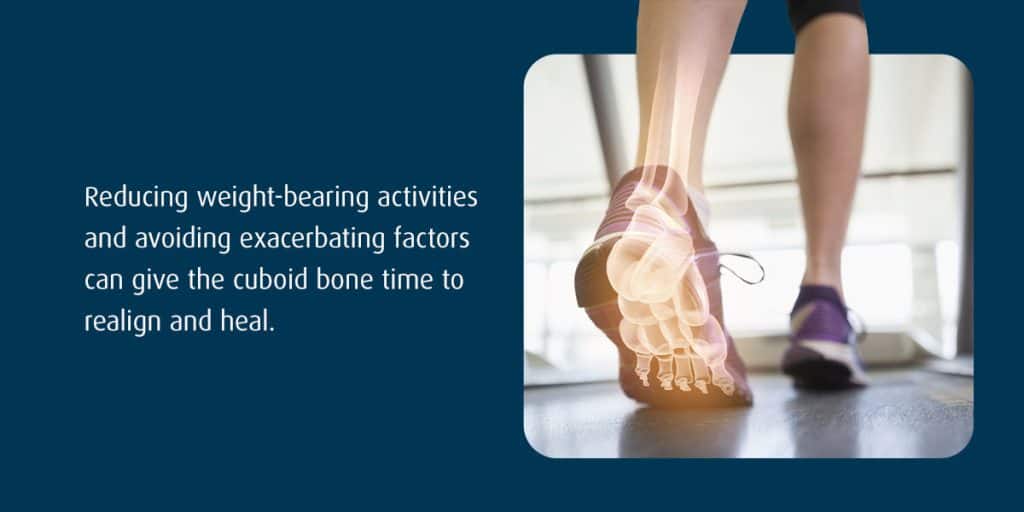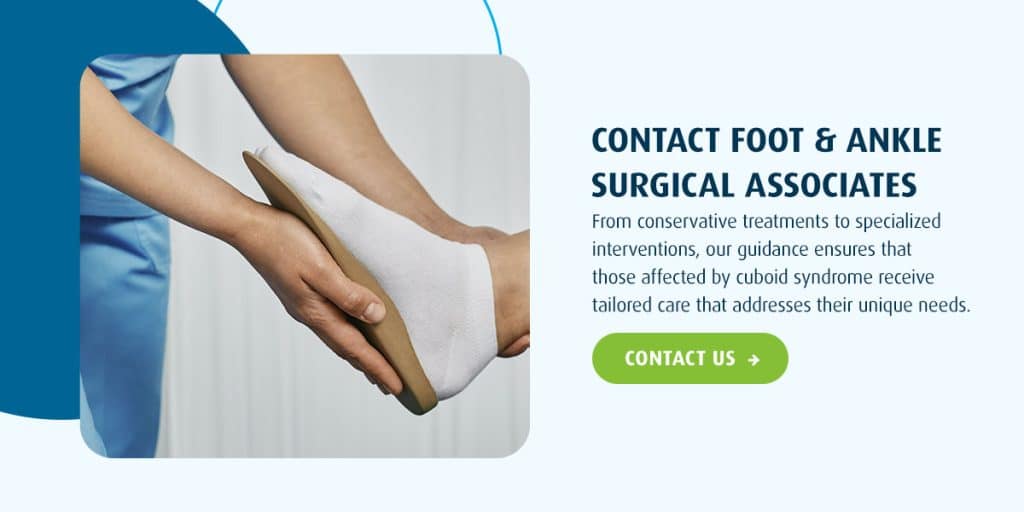Within the architecture of the human body, the feet stand as remarkable foundations that bear the weight of our lives. Beneath the surface, a delicate balance can be disrupted, leading to discomfort and challenges in mobility. The cuboid bone, positioned on the lateral side of the foot, plays a crucial role in maintaining stability and facilitating movements in cuboid feet.
When subjected to misalignment or stress, the cuboid bone can contribute to a unique set of challenges known as cuboid syndrome. This article takes a look at cuboid syndrome and the treatments for it.
Cuboid Syndrome Symptoms
Cuboid syndrome is also known as cuboid subluxation. Another term for it is lateral plantar neuritis. The condition is characterized by the displacement or misalignment of the cuboid bone in the foot. This misalignment disrupts the normal mechanics of the foot and can lead to discomfort, pain and altered gait patterns.
Several factors contribute to the development of cuboid syndrome, such as excessive pronation. This is when the foot rolls inward excessively during walking or running and can strain the supporting structures around the cuboid bone. Additionally, engaging in repetitive activities that stress the foot, such as running or dancing, can lead to overuse injuries that trigger this condition.
Cuboid syndrome presents a distinctive set of symptoms that can vary in intensity. Common indications include:
- Pain and discomfort on the lateral side of the foot that is often described as a deep ache or sharp twinge.
- Pain radiating toward the toes or the heel.
Diagnosing Cuboid Syndrome
A podiatrist or orthopedic specialist will conduct a thorough physical examination, assessing factors like foot alignment, range of motion and palpation of the cuboid bone. Imaging studies such as X-rays or MRI scans might be recommended to rule out other potential causes of the symptoms.
Cuboid Syndrome’s symptoms can overlap with other foot conditions, necessitating a comprehensive assessment. Conditions like stress fractures, ligament sprains or tendon injuries can present similar symptoms. Precise diagnosis ensures the appropriate treatment approach, leading to effective management and relief.
Prompt diagnosis can prevent the escalation of symptoms and the development of chronic issues. Left untreated, cuboid syndrome can lead to gait abnormalities and discomfort that affect daily activities.
Will Cuboid Syndrome Heal on Its Own

In some cases, particularly those with mild symptoms or early detection, cuboid in the foot might resolve independently through rest and self-care. Reducing weight-bearing activities and avoiding exacerbating factors can give the cuboid bone time to realign and heal. Simple interventions like icing the affected area and elevating the foot can help alleviate inflammation and discomfort.
The healing process for cuboid syndrome can vary significantly from person to person. Factors such as the severity of the misalignment, the individual’s overall foot mechanics and the promptness of seeking medical attention all play a role in determining whether the condition will resolve naturally or persist.
Understanding Treatment Approaches
Effectively managing cuboid syndrome requires a multifaceted approach tailored to the individual’s specific condition and needs.
Conservative Treatment
Conservative treatment for Cuboid Syndrome encompasses a range of nonsurgical approaches to relieve discomfort, promote healing and prevent recurrence. This approach is often the initial step in managing the condition and can yield positive results, especially when combined with expert guidance and adherence to recommended strategies:
- Ice and compression: Applying ice and using compression techniques can help reduce inflammation and temporarily relieve discomfort.
- Orthotic support: Custom-made or over-the-counter orthotics can aid in correcting foot alignment and providing additional arch support, easing the strain on the cuboid.
Manual Manipulation
Manual manipulation is a specialized treatment approach to address cuboid syndrome by realigning the misaligned cuboid bone. This technique, performed by trained medical professionals, requires precision and expertise to ensure effective realignment without causing further issues:
- Chiropractic or podiatric manipulation: Chiropractors and podiatrists are skilled in performing manual manipulations to realign the cuboid bone. During this procedure, the medical professional applies controlled and targeted pressure to the cuboid bone, guiding it back into its proper position within the foot’s structure.
- Goals of manual manipulation: The primary goal of manual manipulation is to restore normal alignment to the cuboid bone, relieving strain on surrounding structures and alleviating discomfort. By readjusting the bone’s position, pressure on nerves, tendons and ligaments is reduced, allowing for improved function and reduced pain.
Cuboid Syndrome Exercises
Incorporating targeted exercises into your routine can aid in managing and preventing cuboid syndrome. These exercises focus on strengthening the muscles supporting the cuboid bone, enhancing foot stability and overall foot mechanics. Before starting any exercise regimen, consult with a health care professional to ensure the exercises suit your condition. They may recommend one or more of the following:
- Toe spreading: Sit or stand with your feet resting flat on the floor. Slowly spread the toes as wide as possible, then bring them back together. Repeat this movement for several repetitions, enhancing the flexibility of the foot’s muscles.
- Towel curls: Place a small towel on the floor in front of you. Use your toes to grip the towel and pull it toward you, creating a “curling” motion. Release the towel and repeat the curling movement for multiple reps, strengthening the foot muscles.
- Ankle alphabet: Sit or lie down and trace the letters of the alphabet with your toes. Perform this exercise by moving your ankle and foot to “write” each letter in the air. This exercise enhances ankle mobility and engages the muscles around the cuboid bone.
- Calf raises: Stand with your feet hip-width apart and rise up onto your toes. As you rise up, you lift your heels off the ground. Hold your position on your toes before slowly lowering your heels back down. You can use a wall or a chair to hold onto for balance. Repeat for several rounds.
Supportive Footwear
Supportive footwear provides the foundation for proper alignment, stability and comfort, helping to alleviate strain on the cuboid bone and surrounding structures. Look for these features:
- Arch support: Supportive footwear is characterized by adequate arch support. The arches of the feet help distribute body weight and absorb shock during movement. Shoes with built-in arch support prevent overpronation and contribute to maintaining proper foot mechanics.
- Cushioning: Quality footwear features cushioning in the midsole and heel areas. Cushioning absorbs impact forces, reducing strain on the cuboid bone and minimizing discomfort during walking or other activities.
- Activity-specific shoes: Selecting shoes appropriate for your daily activities is crucial. Running shoes for jogging, walking shoes for strolls and work shoes that meet occupational needs all contribute to foot comfort and proper alignment.

Contact Foot & Ankle Surgical Associates
Foot & Ankle Surgical Associates is committed to elevating the quality of life for individuals. From conservative treatments to specialized interventions, our guidance ensures that those affected by cuboid syndrome receive tailored care that addresses their unique needs.
Collaborating with professionals specializing in foot health, like the experts at Foot & Ankle Surgical Associates, ensures you receive personalized care that aligns with your condition and goals. Contact us today to find out more.



